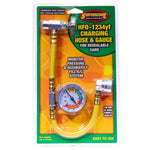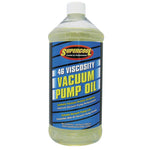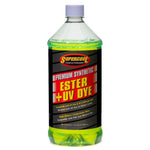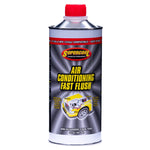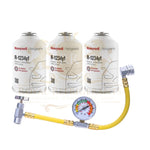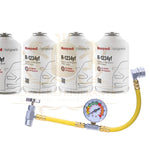You have no items in your shopping cart.
Everything You Need to Know About Banned Refrigerants for HVAC and Automotive Applications
The refrigeration and air conditioning industry has undergone significant changes over the past few decades, primarily due to increasing awareness of environmental issues. Many refrigerants that were once widely used in HVAC and automotive systems are now banned or heavily restricted due to their harmful effects on the ozone layer and climate. Understanding which refrigerants are banned, why they were phased out, and what alternatives are available is essential for technicians, manufacturers, and end-users.
This guide covers everything you need to know about banned refrigerants, including the reasons behind their phase-out and how the industry is transitioning to more sustainable solutions.
What Are Banned Refrigerants?
Banned refrigerants are chemical compounds that were once commonly used for cooling but are now prohibited or severely restricted due to their ozone depletion potential (ODP) or global warming potential (GWP). These refrigerants, especially chlorofluorocarbons (CFCs) and hydrochlorofluorocarbons (HCFCs), contribute significantly to ozone layer depletion and climate change.
Global agreements like the Montreal Protocol (1987) and the Kigali Amendment (2016) set the framework for phasing out these harmful substances and replacing them with more environmentally friendly alternatives.
Why Were Refrigerants Banned?
The main reasons behind banning certain refrigerants include:
- 🌍 Ozone Layer Protection: Many older refrigerants contained chlorine, which breaks down ozone molecules in the atmosphere.
- 🌡️ Reducing Global Warming: Some refrigerants have high GWP, contributing significantly to greenhouse gas emissions.
- ⚖️ Regulatory Compliance: International environmental treaties require countries to phase out ozone-depleting substances and transition to eco-friendly alternatives.
- 🛠️ Industry Modernization: Banning older refrigerants drives innovation and the development of safer, more efficient cooling technologies.
List of Common Banned Refrigerants
1. R12 (CFC-12)
- Type: Chlorofluorocarbon (CFC)
- Use: Automotive A/C, refrigerators, and chillers
- Reason for Ban: Extremely high ODP and GWP (~10,900)
- Status: Phased out globally under the Montreal Protocol.
2. R22 (HCFC-22)
- Type: Hydrochlorofluorocarbon (HCFC)
- Use: Residential and commercial HVAC systems
- Reason for Ban: ODP and GWP (~1,810)
- Status: Production and import banned in most countries (since 2020 in the U.S.).
3. R502 (CFC/HCFC Blend)
- Type: Blend of CFC-115 and HCFC-22
- Use: Commercial refrigeration and low-temperature systems
- Reason for Ban: High ODP and GWP
- Status: Phased out under the Montreal Protocol.
4. R11 (CFC-11)
- Type: Chlorofluorocarbon
- Use: Centrifugal chillers and large A/C systems
- Reason for Ban: Very high ODP and GWP
- Status: Banned since the mid-1990s.
5. R123 (HCFC-123)
- Type: Hydrochlorofluorocarbon
- Use: Centrifugal chillers and HVAC systems
- Reason for Ban: Moderate ODP and high GWP
-
Status: Scheduled for phase-out in many regions by 2030.

Environmental Impact of Banned Refrigerants
The environmental damage caused by older refrigerants is significant:
- 🕳️ Ozone Depletion: CFCs and HCFCs break down ozone molecules, thinning the protective layer that shields Earth from harmful UV radiation.
- 🌡️ Global Warming: Many banned refrigerants have GWPs thousands of times higher than carbon dioxide.
- 🩺 Human Health Risks: Increased UV radiation leads to higher risks of skin cancer, cataracts, and other health issues.
The phase-out of these refrigerants has already led to a gradual recovery of the ozone layer, proving the importance of transitioning to safer alternatives.
Safe and Sustainable Alternatives
Today’s refrigerants are designed to minimize environmental impact while delivering high performance. Popular alternatives include:
- R134a (HFC): A non-ozone-depleting alternative to R12.
- R410A (HFC Blend): A replacement for R22 in many HVAC systems.
- R32 (HFC): Lower GWP than many HFCs and widely used in new A/C systems.
- R1234yf (HFO): Ultra-low GWP refrigerant used in modern automotive A/C systems.
- R717 (Ammonia) & R718 (Water): Natural refrigerants with zero ODP and very low GWP.
Transition Tips for HVAC and Automotive Systems
- 🔧 Retrofit Older Equipment: Many systems using banned refrigerants can be retrofitted to operate with modern alternatives.
- 📜 Follow Regulations: Always comply with local and international refrigerant handling and disposal laws.
- 🧰 Use Certified Technicians: Only trained professionals should recover, recycle, or replace refrigerants.
- 📈 Plan for Future Compliance: Consider refrigerants with very low GWP to future-proof your systems.
Conclusion
The banning of harmful refrigerants has been a critical step toward protecting the environment and human health. While substances like R12, R22, and R502 once dominated the HVAC and automotive industries, their high ozone depletion and global warming potential made them unsustainable. The good news is that advanced alternatives like R1234yf, R410A, and R717 offer efficient, safe, and eco-friendly cooling solutions.
As global regulations continue to evolve, transitioning away from banned refrigerants is not just an environmental responsibility — it’s a smart, future-ready decision for any HVAC or automotive system.
 English
English

